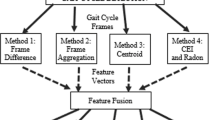Abstract
Gait has emerged as a new biometric verification method which helps in recognising a person by his walking style. In this paper, gait features are extracted based on information set theory, which itself is derived from fuzzy set theory. The uncertainty in the information source values is taken into account by entropy function, based on which gait information image (GII) is derived from a gait cycle. For this purpose a new GII based feature named bipolar sigmoid feature (GII-BPSF) is proposed. Moreover, to address the problem of orientation normalization for different view angles, a modified pre-processing method is adapted from the study of He et al. (The role of size normalization on the recognition rate of handwritten numerals, 2005) to verify the robustness of the proposed features, experiments were carried out on CASIA (Institute of Automation, Chinese Academy of Sciences) dataset B with a wide range of subject variation, different clothing patterns, and carrying conditions. The experimental results show that the proposed GII-BPSF is a more efficient gait representation and feature for an individual recognition and the obtained identification rates are higher concerning the previously established gait recognition approaches.






Similar content being viewed by others
Explore related subjects
Discover the latest articles, news and stories from top researchers in related subjects.Notes
A rank n is given to a test case when it is nth closest match corresponding to its trained sample in the classifier used. For example, rank 5 depicts that the trained sample corresponding to its test case lies in top 5 matches. In our study, the maximum rank can be the 124 i.e. the total number of subjects. In Fig. 5, the maximum rank achieved is less than 60 which itself proves the robustness of GII-BPSF i.e. every test case can be found under at-most 60 rank, and the identification rate is understood to be 100% for all ranks above 60 till 124.
References
Arora, P., Hanmandlu, M., Srivastava, S.: Gait based authentication using gait information image features. Pattern Recognit. Lett. 68(Part 2), 336–342 (2015). (Special Issue on Soft Biometrics)
Bashir, K., Xiang, T., Gong, S.: Gait recognition using gait entropy image. In: 3rd International Conference on Imaging for Crime Detection and Prevention (ICDP 2009), pp. 1–6 (2009)
Cunado, D., Nixon, M.S., Carter, J.N.: Using Gait as a Biometric, Via Phase-Weighted Magnitude Spectra, pp. 93–102. Springer, Berlin (1997)
Cutting, J.E., Kozlowski, L.T.: Recognizing friends by their walk: gait perception without familiarity cues. Bull. Psychon. Soc. 9(5), 353–356 (1977)
Hanmandlu, M., Das, A.: Content-based image retrieval by information theoretic measure. Def. Sci. J. 61(5), 415–430 (2011)
He, C.L., Zhang, P., Dong, J.X., Suen, C.Y., Bui, T.D.: The role of size normalization on the recognition rate of handwritten numerals. In: Proceedings of IAPR TC3 Workshop of 8th International Conference on Document Analysis and Recognition: Neural Networks and Learning in Document Analysis and Recognition (2005)
Hu, M., Wang, Y., Zhang, Z., Wang, Y.: Combining spatial and temporal information for gait based gender classification. In: 2010 20th International Conference on Pattern Recognition, pp. 3679–3682 (2010)
Johansson, G.: Visual perception of biological motion and a model for its analysis. Percept. Psychophys. 14(2), 201–211 (1973)
Lam, T.H., Cheung, K., Liu, J.N.: Gait flow image: a silhouette-based gait representation for human identification. Pattern Recogn. 44(4), 973–987 (2011)
Lee, L., Grimson, W.E.L.: Gait analysis for recognition and classification. In: Fifth IEEE International Conference on Automatic Face and Gesture Recognition, 2002. Proceedings, pp. 148–155 (2002)
Little, J.J., Boyd, J.E.: Recognizing people by their gait: the shape of motion. The MIT Press, Cambridge (1998)
Man, J., Bhanu, B.: Individual recognition using gait energy image. IEEE Trans. Pattern Anal. Mach. Intell. 28, 316–322 (2006)
Murase, H., Sakai, R.: Moving object recognition in eigenspace representation: gait analysis and lip reading. Pattern Recogn. Lett. 17(2), 155–162 (1996)
Niyogi, S.A., Adelson, E.H.: Analyzing and recognizing walking figures in XYT, pp. 469–474, EEE (1994)
Pal, N.R., Pal, S.K.: Entropy: a new definition and its applications. IEEE Trans. Syst. Man Cybern. 21(5), 1260–1270 (1991)
Preis, J., Kessel, M., Werner, M., Linnhoff-Popien, C.: Gait recognition with kinect. In: 1st international workshop on kinect in pervasive computing, pp. P1–P4, New Castle, UK (2012)
Rokanujjaman, M., Islam, M.S., Hossain, M.A., Islam, M.R., Makihara, Y., Yagi, Y.: Effective part-based gait identification using frequency-domain gait entropy features. Multimed. Tools Appl. 74(9), 3099–3120 (2015)
Shannon, C.E.: A mathematical theory of communication. Bell Syst. Tech. J. 27, 379–423 (1948)
Yoo, J.-H., Nixon, M.S., Harris, C.J.: Model-driven statistical analysis of human gait motion. In: 2002 International Conference on Image Processing. 2002. Proceedings, vol. 1, pp. I–285, IEEE (2002)
Yu, S., Tan, T., Huang, K., Jia, K., Wu, X.: A study on gait-based gender classification. IEEE Trans. Image Process. 18, 1905–1910 (2009)
Zhang, Z., Hu, M., Wang, Y.: A Survey of Advances in Biometric Gait Recognition, pp. 150–158. Springer, Berlin (2011)
Zheng, S., Zhang, J., Huang, K., He, R., Tan, T.: Robust view transformation model for gait recognition. In: 2011 18th IEEE International Conference on Image Processing, pp. 2073–2076 (2011)
Funding
This research did not receive any specific Grant from funding agencies in the public, commercial, or not-for-profit sectors.
Author information
Authors and Affiliations
Corresponding author
Rights and permissions
About this article
Cite this article
Sharma, H., Grover, J. Human identification based on gait recognition for multiple view angles. Int J Intell Robot Appl 2, 372–380 (2018). https://doi.org/10.1007/s41315-018-0061-y
Received:
Accepted:
Published:
Issue Date:
DOI: https://doi.org/10.1007/s41315-018-0061-y





